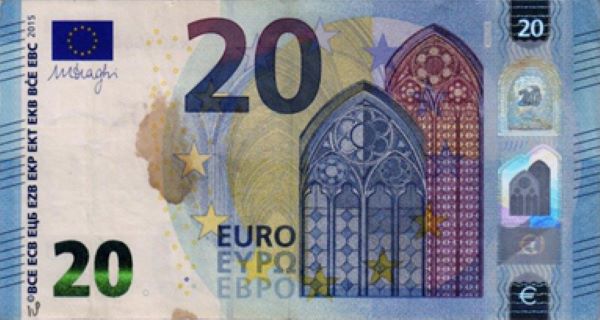
Damaged and ink-stained banknotes
Damaged banknotes
The national central banks in the euro area work to make sure that all euro banknotes are authentic and not damaged or dirty before putting them back into circulation. The central banks employ fully automated machines to check and sort the banknotes they receive to maintain high standards of quality. Dirty or damaged banknotes are destroyed.
Can I get my banknotes replaced or reimbursed?
The national central banks in the euro area replace any euro banknotes that are accidentally damaged, torn or mutilated, provided certain criteria are met. If you possess more than half of a damaged euro banknote, or if you can prove that the missing part of the banknote has been destroyed, the national central bank can replace it. Intentionally mutilated or damaged euro banknotes are not replaced.
As a general rule, replacement is free of charge. Please contact your respective national central bank for more information.
Ink-stained banknotes
Have you ever come across a banknote covered with ink?
If someone tries to give you a banknote that is covered in ink, do not accept it, as it was probably stolen. Some ink-stained banknotes have been damaged by anti-theft devices as a result of criminal activity. The ink comes from intelligent banknote neutralisation systems, which are activated when criminals open a protected cash container like an ATM or a safe in an armoured car. These anti-theft systems make stolen banknotes unusable and worthless, thus reducing the risk of retailers, banks and other professional cash handlers falling victim to crime.


While ink is one of the most common methods for making stolen banknotes unusable, other tools are also employed to protect cash, such as glue. Glue fuses all the banknotes inside an ATM cassette together into a solid brick. If you try to peel off individual banknotes, they tear into pieces.

How to recognise a stolen ink-stained banknote?
When a banknote is stained by an anti-theft device, the security ink soaks into the banknote. The most commonly used security inks are bright violet, green, blue, red or black in colour. The ink usually flows from the edges towards the centre of the banknotes and leaves a characteristic pattern. Sometimes, the chemicals that criminals use to remove the ink can cause discolouration. As a result, the banknotes’ original colours could also be altered, and some security features may be damaged or may even disappear.
Are all ink-stained banknotes stolen?
No. If there are very light stains or only a couple of small marks on the banknote and the edges are intact, then the marks are most likely accidental. Such stains might be caused by a leaky pen, for instance, rather than an anti-theft device. Banknotes like this are unlikely to be stolen and can be accepted.



What if someone gives me an ink-stained banknote clearly stained by an anti-theft device?
- Don’t accept it – ask for another one. You can’t be sure that the person offering you the banknote is the rightful owner.
Refuse bleached or discoloured banknotes, as criminals have most likely tried to remove anti-theft ink stains by washing or bleaching the notes.
If you have accepted an ink-stained banknote, you should take it to your bank or a national central bank and let them know how you got it. The national central bank will check if the ink stains are from an anti-theft device and may call in the police, who can use the banknotes as evidence in their investigations.
You may not be entitled to a reimbursement if the investigations reveal that the ink stains are from an anti-theft device. National central banks can exchange euro banknotes stained by anti-theft devices only at the request of the original banknote owner who was the victim of the criminal activity that led to the banknotes being stained.
If the investigations confirm that the ink stains are not from an anti-theft device and the banknote has just been marked accidentally, you will receive a new banknote or the amount will be credited to your bank account.
Do you have any further questions? Article 3 of the Decision of the European Central Bank on the exchange of damaged euro banknotes may have the answers.


